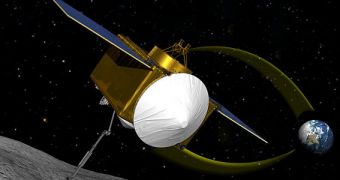Officials with the American space agency announce that the NASA Origins Spectral Interpretation Resource Identification Security Regolith Explorer (OSIRIS-REx) mission has successfully completed its Mission Critical Design Review (CDR) on Wednesday, April 9. This marks a very important milestone in the project, because now contractors can go ahead and begin constructing the probe.
The CDR was held between April 1-9 at a Lockheed Martin Space Systems Company facility in Littleton, Colorado. The review looked over the designs for all the systems that will comprise this ambitious mission, including the actual spacecraft, its flight and scientific instruments, all associated ground system, and related launch support facilities.
The review board was comprised of experts from NASA and a wide array of external organizations whose job was to provide an independent review of the entire project, its successes, promises, failures, and challenges. The CRD panel approved OSIRIS-REx for further development, meaning that NASA's main contractor, Denver, Colorado-based Lockheed Martin, can now begin constructing the spacecraft.
According to OSIRIS-REx Program Executive Gordon Johnston from NASA Headquarters in Washington DC, the CDR “is the final step for a NASA mission to go from paper to product. This confirms that the final design is ready to start the build-up towards launch.”
NASA says that the mission will cost around $800 million (€577 million) and is scheduled to launch in September 2016 from Space Launch Complex 41 (SLC-41) at the Cape Canaveral Air Force Station (CCAFS) in Florida. The probe will weigh 1,529 kilograms (3,371 pounds) at launch and will be delivered to space aboard a United Launch Alliance Atlas V rocket.
OSIRIS-REx is being developed by the Lunar and Planetary Laboratory (LPL) at the University of Arizona in Tucson, the NASA Goddard Space Flight Center (GSFC) in Greenbelt, Maryland, and Lockheed Martin Space Systems. The mission is scheduled to last for at least 7 years, with arrival at asteroid (101955) Bennu scheduled for 2018. The probe will spend 505 days in orbit around Bennu.
“Successfully passing mission CDR is a major accomplishment, but the hard part is still in front of us -- building, integrating and testing the flight system in support of a tight planetary launch window,” comments GSFC OSIRIS-REx Project Manager Mike Donnelly.
After it studies the asteroid for more than a year, the spacecraft will deploy a small lander which will affix itself to the space rock, collect at least 60 grams (2 ounces) of material, and then return to Earth for study. Arrival is estimated for sometime in 2023.
Besides NASA's Stardust spacecraft and Japan Aerospace Exploration Agency's (JAXA) Hayabusa probe, no other relevant sample-return missions were able to deliver material from another celestial body back to Earth. Notable exceptions include the Soviet Luna program and the Apollo missions.
However, this streak of bad luck may end with the new mission. “The OSIRIS-REx team has consistently demonstrated its ability to present a comprehensive mission design that meets all requirements within the resources provided by NASA,” explains UAT principal mission investigator, Dante Lauretta.
“Mission CDR was no exception. This is a great team. I know we will build a flight and ground system that is up to the challenges of this ambitious mission,” he concludes.

 14 DAY TRIAL //
14 DAY TRIAL //